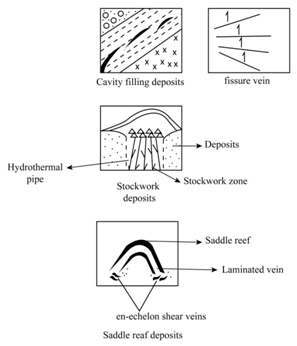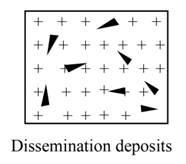ketch, label, and describe how hydrothermal processes form vein deposits related to igneous intrusions (magma chambers). Also, include where and how disseminated deposits form.
Sketch, label, and describe how hydrothermal processes form vein deposits related to igneous intrusions (magma chambers). Also, include where and how disseminated deposits form.
The epigenetic ore deposits formed by hydrothermal solutions are called hydrothermal ore deposits. The hydrothermal solution moves through cracks and openings present in the rocks and deposits their minerals there. The ore deposits commonly formed by the hydrothermal processes are gold, silver, copper, lead, zinc, and mercury.
Vein deposits are the type of deposits found along with the fractures present in the rocks. These deposits are formed when hydrothermal solution deposits dissolve their minerals in rock openings. Various types of vein deposits are found in nature. Some are mentioned below:
Fissure veins, stockworks, saddle reefs, cavity filling deposits.
Stockworks are formed when rock mass traversed by a network of small ore-bearing veinlets. These veinlets are filled with minerals. These yield low-grade deposits. Gold, silver is found here. When alternate competent and incompetent rocks are closely folded, folding develops an opening in the arch's crest. Structures resemble saddle. Fissure veins are mineral deposits in a crack of a rock. Fissure filled with ore. Mostly cavity filling deposits are associated with carbonate rocks. These are shallow depth deposits.

When a magma crystallizes under deep-seated conditions, granular igneous rock is formed. In such a rock, the early formed crystals of ore minerals may occur in dissemination. Here grains of rock are found scattered more or less throughout the rock mass. Hence the whole rock mass constitutes the ore deposit. These disseminated deposits occur in the shape of a fyke, pipe, or small stock like mass.

Step by step
Solved in 3 steps with 2 images









